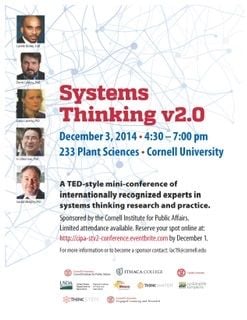We Build Capacity to Do Our Mission
 Derek & Laura Cabrera
·
3 minute read
Derek & Laura Cabrera
·
3 minute read
This post is an excerpt from Chapter 4 of Flock Not Clock.
What is capacity? Capacity is a general term, used in disciplines from physics and mathematics to the military and ecology. Capacity is potential energy. Capacity is a state of preparedness or readiness to do something. But, more specifically, organizational capacity is the energy to do the mission. In other words, it is quite possible that you know exactly what your mission is and that you even have the opportunity to do your mission (i.e., you have a customer ready to be served), yet you do not have the capacity to actually serve them. That is why your organization needs to prepare itself by building capacity to do what it wants to repeatedly do (your mission).
Capacity—the form of the word that is synonymous with capability—denotes the ability or power to produce, perform, or deploy. People (and all other organisms) have capacity, objects have capacity, and organizations have capacity. But saying one has capacity immediately begs the question: the capacity for what? Capacity is made meaningful when tied to a purpose. Let’s consider this both abstractly and in simple terms. The two containers in Figure 4.1 are similar in function and size and purpose (the capacity to hold liquid). But one structural difference leads one container to have less capacity than the other. The hole in one container means it has diminished capacity to achieve it’s purpose and hold water (i.e., “do the mission”).
 Figure 4.1: Two similar structures with different capacity
Figure 4.1: Two similar structures with different capacity
Capacity Is a State of Readiness to Do Your Mission
A state of readiness to do your mission entirely depends on the capacity an organization develops. Motivation or desire to do something is not enough: you must build the capacity needed to accomplish your goals. Action of any kind requires capacity. Whenever you have something to do (mission), you need to also have the capacity to do it. This means that capacity isn’t just a nice thing to consider—it is a universal function of all organisms and organizations. It is required, not optional. This relationship between action and capacity applies as much to physical objects and individuals as it does to organizations.
Let’s look at an example. If you’ve ever prepared for a big talk, a big game, a big meeting, or a big test, you know that there’s a moment when all the preparations are done and it’s time to perform. Everything prior to that moment is capacity. After that moment is mission (i.e., the action). That’s the reason the Boy Scout motto is “Be prepared.” It is the reason Olympic athletes and musicians practice. Capacity is what you have in the tank when it’s time to perform.
Far too often, we are clear on what we want to do, but are less clear on all the things that need to be in place in order to do it. Think about a restaurant you dined at recently. Your experience was mostly informed by the overall level of service provided throughout your meal. What you don’t see is the different types of capacity that were built to facilitate the moment your meal arrived. For example, the owner purchased all the ingredients for your food; the chef prepared the meal; another company delivered fresh linens; someone washed all the glasses; and each server, busser, chef, sommelier, maître d', and dishwasher received training. The aggregation of all these things—not just in the abstract, but as a shared mental model in the hearts and minds of the entire restaurant staff—is the restaurant’s capacity, its readiness and ability to serve you. In other words, without meticulous attention to the range of capacity systems needed to do their mission of providing you with an exceptional experience, the restaurant would fail.
 Figure 4.2: Successful mission moments depend upon capacity
Figure 4.2: Successful mission moments depend upon capacity
This is true of all individuals and groups. You can’t run on vision alone, you need to know the actions you need to repeatedly take (mission) to get you there. But you also need to know what capacity is required to do the mission.
You can build capacity in a lot of ways that don’t help your business. So it becomes essential to ask yourself, “The capacity to do what?” to make sure that you are building not just any capacity, but the right capacity. In the same way that your vision and mission need to be aligned, so too does your mission and capacity. So when we say that you need to build capacity, what we really mean is that you need to build a system of mission-critical systems. Then we can stay closer to the original purpose of these systems—to provide capacity to do the mission, which in turn achieves the vision.
.png?width=150&height=150&name=CRL%20GOAT%20Logo%20(4).png)



